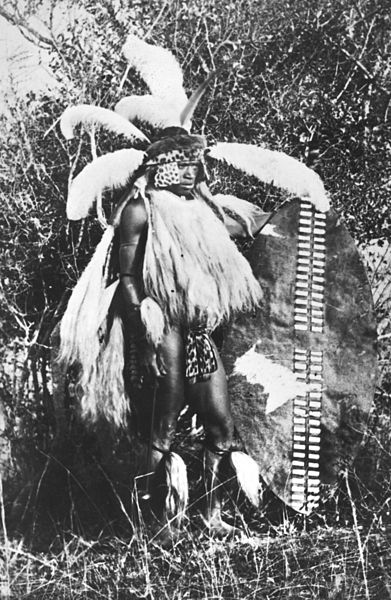Impi is a Nguni word meaning war or combat and by association any body of men gathered for war, for example impi ya masosha is a term denoting an army. Impi were formed from regiments from large militarised homesteads. In English impi is often used to refer to a Zulu regiment, which is called an ibutho in Zulu or the army.
The impi was a military formation that transformed the face of southern Africa, on into east and central Africa. Its highest development took place under Shaka, initiator of several important organizational, weapon and tactical innovations.
Zulu warrior armed with the iklwa stabbing spear (assegai) and iwisa club (knobkerrie). His kilt is of genet tails
"Ready for War"; "A Zulu"; "Zulu Policemen" – the man pictured to the right wears the head-ring (isicoco) denoting his married status
Zulu warrior in full regimental regalia, carrying the large isihlangu war shield. c. 1860. The upper body is covered in cow tails, the kilt is of spotted cat, genet or civet skin and the shins are decorated with cowtails. The elaborate headdress consists of a browband and face-framing flaps of leopard skin with another band of otter skin above. There are multiple ostrich feather plumes and a single upright crane's feather.
Shaka kaSenzangakhona, also known as Shaka Zulu and Sigidi kaSenzangakhona, was the king of the Zulu Kingdom from 1816 to 1828. One of the most influential monarchs of the Zulu, he ordered wide-reaching reforms that reorganized the military into a formidable force.
1824 European artist's impression of Shaka with a long throwing assegai and heavy shield. No drawings from life are known.
Large statue representing Shaka (rather obviously based on actor Henry Cele) at the Camden markets in London, England.
A sketch of a Zulu warrior, drawn in 1913.
Shaka's methods reached their high point during the Zulu victory at Isandhlwana. Regimental deployments and lines of the attack showed his classic template at work.








